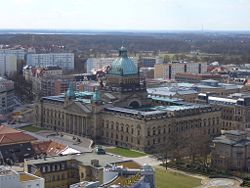Leipzig: Difference between revisions
imported>Alexander Wiebel (typos) |
mNo edit summary |
||
| (13 intermediate revisions by 5 users not shown) | |||
| Line 1: | Line 1: | ||
'''Leipzig''' is a city in the federal state of [[Saxony]], [[Germany]]. With a population of | {{subpages}} | ||
'''Leipzig''' is a city in the federal state of [[Saxony]], [[Germany]]. With a population of 507,360<ref>[http://www.statistik.sachsen.de/21/02_02/02_02_06g_tabelle.asp www.statistik.sachsen.de], 2007-06-30.</ref> it is the second largest city in the eastern part of Germany and the largest city of Saxony. It has an area of 297.6 km²<ref>[http://www.statistik.sachsen.de/21/02_01/02_01_23_tabelle.asp www.statistik.sachsen.de].</ref>. | |||
[[Image:Leipzig Innenstadt.jpg|right|thumb|350px|{{#ifexist:Template:Leipzig Innenstadt.jpg/credit|{{City-Hochhaus Leipzig.jpg/credit}}<br/>|}}Leipzig town center viewed from [[Völkerschlachtdenkmal]]. Tower of Altes Rathaus in the left, City-Hochhaus in the middle and Messe-Hochhaus in the right of the image.]] | |||
== Government == | == Government == | ||
| Line 8: | Line 11: | ||
=== Architecture === | === Architecture === | ||
[[Image:Reichsgericht Leipzig.jpg|right|thumb|250px|{{#ifexist:Template:Reichsgericht Leipzig.jpg/credit|{{City-Hochhaus Leipzig.jpg/credit}}<br/>|}}Reichsgericht building in Leipzig, home of the [[Federal Administrative Court of Germany]] ]] | |||
{{Image|City-Hochhaus Leipzig.jpg|right|250px|City-Hochhaus with parts of the Gewandhaus (left) and university main building (right). It belonged to the university's city campus.}} | |||
Some of the historically and architecturally important buildings are listed in the following: | Some of the historically and architecturally important buildings are listed in the following: | ||
* Thomas Church | * Thomaskirche (St Thomas' Church) | ||
* | : [[Johann Sebastian Bach]] was cantor here. | ||
* Nikolaikirche (St Nicholas' Church) | |||
* Völkerschlachtdenkmal ("Monument of the Battle of the Nations") | * Völkerschlachtdenkmal ("Monument of the Battle of the Nations") | ||
* Gewandhaus | * Gewandhaus | ||
: Home of the famous Gewandhaus Orchestra. The current Gewandhaus ist the third building with this name. | |||
* Reichsgericht | * Reichsgericht | ||
* | : Home of the [[Federal Administrative Court of Germany]]. | ||
* | * Neues Rathaus (new city hall) | ||
: Though built in the beginning of the 20th century, its style resembles a castle. | |||
* Altes Rathaus (old city hall) | |||
* Main Station | * Main Station | ||
: Largest terminus station in Germany. Taking only the area into account it is the largest terminus station in Europe. | |||
* Mädlerpassage | * Mädlerpassage | ||
* City-Hochhaus | |||
: Formerly known as Uni Riese (University Giant) it belonged to the university's city campus when it was built. | |||
* Messe-Hochaus | |||
== Institutions == | == Institutions == | ||
| Line 25: | Line 40: | ||
The university of Leipzig is the second eldest university in modern Germany. In addition to the university there exist a couple of universities of applied sciences ("Fachhochschule"), music schools and art schools. Research is conducted at the university, three Max Planck institutes and several smaller institutes. | The university of Leipzig is the second eldest university in modern Germany. In addition to the university there exist a couple of universities of applied sciences ("Fachhochschule"), music schools and art schools. Research is conducted at the university, three Max Planck institutes and several smaller institutes. | ||
[[Category: | == References == | ||
<references />[[Category:Suggestion Bot Tag]] | |||
Latest revision as of 06:00, 11 September 2024
Leipzig is a city in the federal state of Saxony, Germany. With a population of 507,360[1] it is the second largest city in the eastern part of Germany and the largest city of Saxony. It has an area of 297.6 km²[2].

Leipzig town center viewed from Völkerschlachtdenkmal. Tower of Altes Rathaus in the left, City-Hochhaus in the middle and Messe-Hochhaus in the right of the image.
Government
The mayor of Leipzig is Burkhard Jung (SPD). He was elected in 2006. His predecessor Wolfgang Tiefensee left Leipzig in 2005 and became Federal Minister of Transport, Building and Urban Affairs of Germany.
Cityscape
Leipzig is famous for its large Gründerzeit style housing areas.
Architecture

Reichsgericht building in Leipzig, home of the Federal Administrative Court of Germany
Some of the historically and architecturally important buildings are listed in the following:
- Thomaskirche (St Thomas' Church)
- Johann Sebastian Bach was cantor here.
- Nikolaikirche (St Nicholas' Church)
- Völkerschlachtdenkmal ("Monument of the Battle of the Nations")
- Gewandhaus
- Home of the famous Gewandhaus Orchestra. The current Gewandhaus ist the third building with this name.
- Reichsgericht
- Home of the Federal Administrative Court of Germany.
- Neues Rathaus (new city hall)
- Though built in the beginning of the 20th century, its style resembles a castle.
- Altes Rathaus (old city hall)
- Main Station
- Largest terminus station in Germany. Taking only the area into account it is the largest terminus station in Europe.
- Mädlerpassage
- City-Hochhaus
- Formerly known as Uni Riese (University Giant) it belonged to the university's city campus when it was built.
- Messe-Hochaus
Institutions
The Bundesverwaltungsgericht (Federal Administrative Court of Germany) and a part of the Bundesgerichtshof (Federal Court of Justice of Germany) are located in Leipzig. Leipzig is also one of the sites of the German National Library. The Deutsche Bücherei which is located in Leipzig was combined with the Deutsche Bibliothek which is located in Frankfurt am Main to form the German National Library after the reunification of Germany.
Education
The university of Leipzig is the second eldest university in modern Germany. In addition to the university there exist a couple of universities of applied sciences ("Fachhochschule"), music schools and art schools. Research is conducted at the university, three Max Planck institutes and several smaller institutes.
References
- ↑ www.statistik.sachsen.de, 2007-06-30.
- ↑ www.statistik.sachsen.de.
